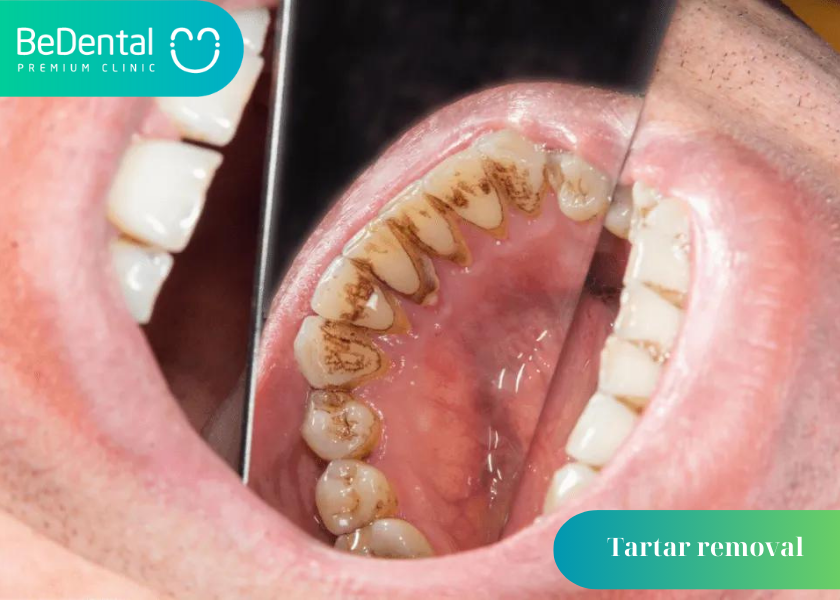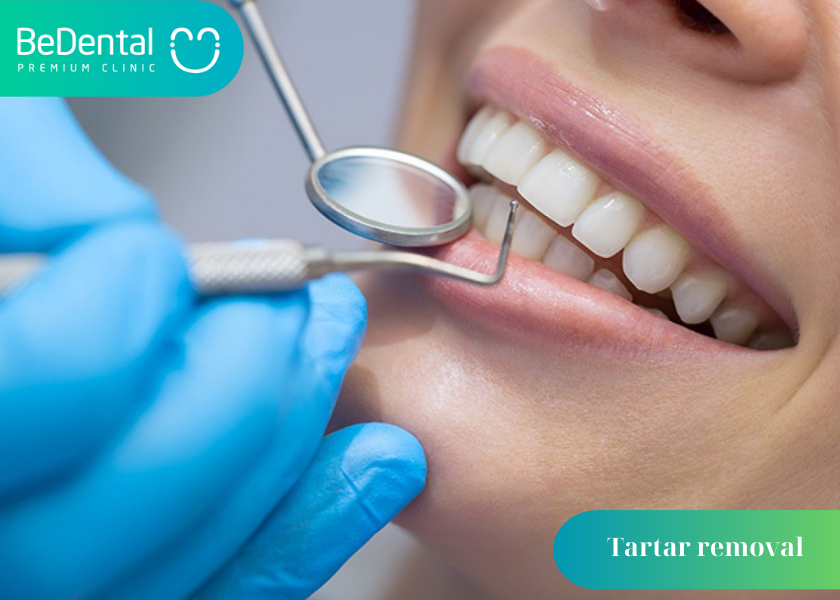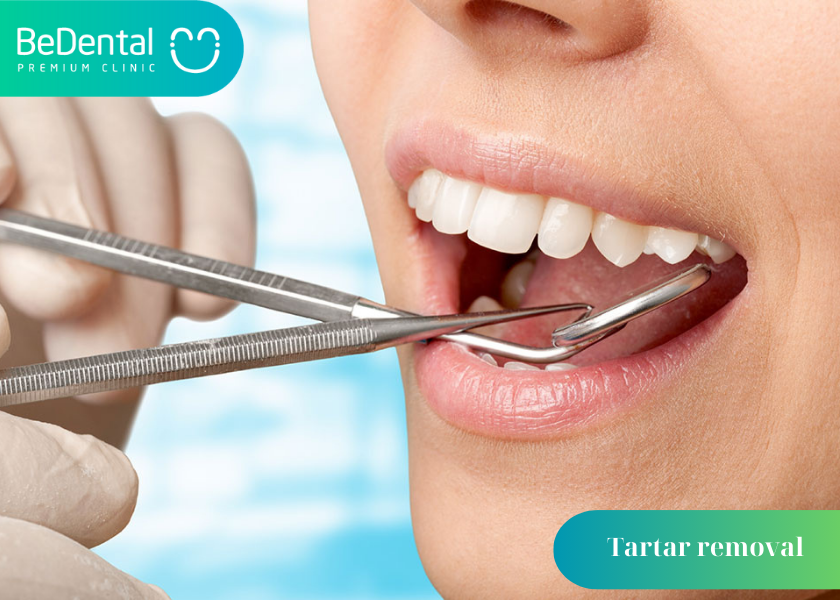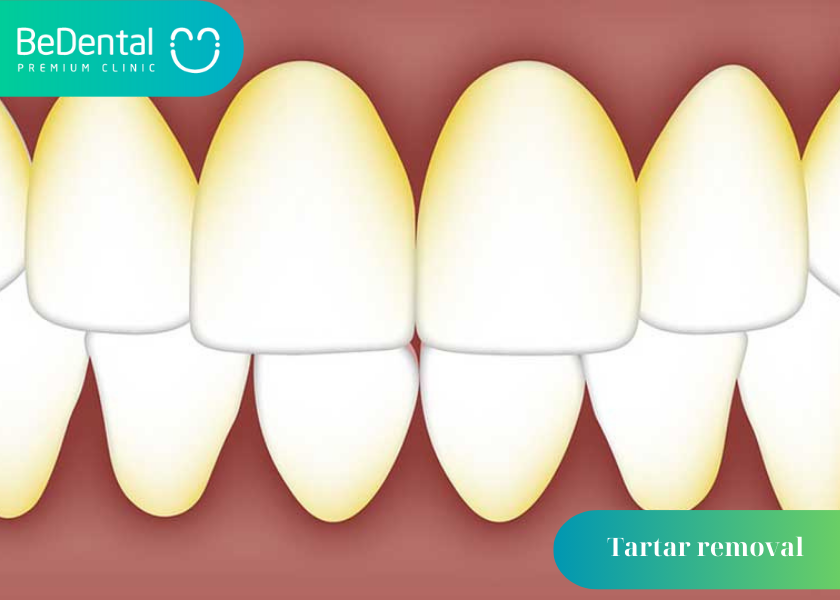How Long Does Tartar Removal Take? This is a common question people ask when considering the decision to remove tartar. The process of tartar removal is not just a simple examination and intervention, but it requires careful aftercare and monitoring. Let’s explore this topic with BeDental in the article below!
1) Understanding Tartar
Before answering “How long does tartar removal take?”, you should understand tartar removal first! Tartar removal is a dental procedure used to eliminate food debris and bacteria on the teeth and in the oral cavity. Using specialized tools, dentists directly act on the plaque on the teeth, then remove it from the teeth and gums.

The tartar removal method offers many benefits for oral health, including:
- Reducing the risk of common oral diseases such as gingivitis, periodontitis, enamel erosion, gum recession… These conditions are often caused by bacteria in dental plaque. Regular tartar removal is an effective way to prevent bacterial growth and the development of these diseases.
- Limiting bad breath and providing fresh breath. The bacteria and plaque in tartar create an unpleasant odor. Regular tartar removal helps resolve this issue and brings fresh breath.
- Improving tooth color to be brighter: Tartar buildup on the surface of the teeth makes them yellowish, dull, and affects aesthetics. Therefore, tartar removal becomes a necessary method to address this issue.
- Protecting the health of teeth and jawbone: Tartar buildup in the mouth creates a favorable environment for harmful bacteria that can damage the teeth and gums. This can lead to bone loss, tooth mobility, and even tooth loss. Therefore, tartar removal is essential to protect the health of teeth and jawbone.
2) Is Tartar Removal Necessary?
Before answering “How long does tartar removal take?”, you should the importance of tartar removal. Tartar, also known as dental calculus, is essentially plaque and food debris left in the mouth, often concentrated in the gaps between the teeth and near the gum line. Over time and under the influence of bacteria, these remnants become hard and thick deposits on the teeth and gums. Tartar has an opaque white or yellowish-brown color, and it can even turn black, causing aesthetic issues and impacting oral health.
When tartar accumulates for a long time, the amount increases, and the color becomes darker, which can lead to various oral health problems such as bleeding gums, gum recession, bad breath, enamel damage, gingivitis, pulpitis, tooth decay, oral mucositis, tonsillitis, and other conditions.

Since tartar adheres firmly to the tooth surface, it cannot be cleaned with regular brushing and requires specialized cleaning tools. When visiting a dental clinic, the dentist may use ultrasonic waves combined with water pressure to clean the plaque and tartar on the gums. Experts recommend having tartar removed periodically every 3 to 6 months to avoid the harmful effects of tartar.
3) How Long Does Tartar Removal Take?
See more: What to do if lose tooth number 7
How long does tartar removal take? Typically, tartar removal is a simple and quick procedure, usually taking less than 30 minutes to complete. However, if considering the overall process of tartar removal, additional time may be needed to complete other examination and treatment steps. These steps include:
- Step 1: Examination and consultation regarding the plaque and tartar on your teeth.
- Step 2: Using specialized tools to remove plaque from the teeth and gums in all areas of the dental arch.
- Step 3: Polishing the teeth and deep cleaning.

4) Does Tartar Removal Hurt?
People often ask if the process is painful. The answer depends on the following factors:
- Oral health status: If you have oral health issues such as gingivitis or periodontitis, tartar removal may be more painful than for those with healthy teeth.
- Amount of tartar: Tartar is usually concentrated at the gum line and between the teeth, and in this case, tartar removal does not cause pain or bleeding. However, if tartar is deeply embedded under the gums and causes inflammation, swelling, the removal process may cause discomfort, but it typically only lasts a few days and then subsides.
- Dentist’s technique: A dentist with high skills and experience will perform the tartar removal process correctly, without affecting the surrounding structures, thus avoiding post-treatment discomfort.
- Equipment and tools used: Reputable dental clinics now use ultrasonic tartar removal technology, which allows flexible movement around the teeth. This technique enables the quick removal of plaque without affecting the teeth and gums.
See more: Permanent Tooth decay treatment and causes
5) Benefits of Regular Tartar Removal
5.1. Benefits of Regular Tartar Removal: Reducing the risk of oral diseases
Tartar buildup at the gum line and between the teeth provides favorable conditions for bacterial growth and disease. People with oral health issues such as periodontitis, gingivitis, or gum recession often fail to effectively remove tartar regularly, leading to an increased risk of oral diseases.
5.2. Benefits of Regular Tartar Removal: Limiting bad breath and providing fresh breath
Bacteria that live on tartar along with the decomposition of food trapped between the teeth cause bad breath. Regular tartar removal will help eliminate this issue, providing fresh breath and boosting confidence.
5.3. Benefits of Regular Tartar Removal: Achieving a bright smile
Tartar buildup with its yellowish or brown color reduces the aesthetics of teeth, making them yellow and dull. Regular tartar removal is essential for maintaining a bright and clean smile over time.

6) How Often Should Tartar Be Removed?
In addition to wondering how long does tartar removal take?, people often ask how often should tartar be removed. While tartar removal provides many benefits, it should not be done too frequently, as the use of ultrasonic waves and strong pressure can damage the teeth and gums. Too frequent tartar removal will not give the teeth enough time to rest, leading to tooth pain, sensitivity, discomfort, and even tooth loosening.
Experts recommend an average interval of 6 months between tartar removal sessions. This period is suitable for tartar not to cause too many issues for oral health and enough time for the teeth and gums to recover after the previous tartar removal. However, for extra caution, the dentist will examine and determine if tartar removal is necessary, how long does tartar removal take and treat any related oral health issues if present.

Although the 6-month interval is a general recommendation for everyone, it may vary depending on the individual’s tooth structure, dietary habits, and oral hygiene practices. However, some groups may need more frequent tartar removal:
- People who regularly use stimulants such as smoking, drinking alcohol, or consuming a lot of coffee, as these increase the rate of tartar formation.
- People with rough enamel, as this condition allows tartar to form and accumulate more easily on the tooth surface and gums.
- Young children, especially those under 10 years old, who need regular tartar removal and careful oral health check-ups, with the tartar removal process done gently.
7) How to Care for Teeth After Tartar Removal
Beside “How long does tartar removal take?”, you should know “How to care for teeth after tartar removal”. Proper aftercare is crucial to help the teeth and gums recover quickly and prevent excessive tartar buildup. Here are some guidelines for oral hygiene and care after tartar removal:
- Regularly remove tartar and check oral health every 6 months.
- Brush your teeth with a soft toothbrush at least 2-3 times a day, especially after eating, to remove bacteria and food debris.
- Use dental floss to remove food particles stuck between the teeth and in hard-to-clean areas.
- Rinse your mouth with saltwater or a specialized mouthwash containing antibacterial agents to reduce tartar buildup.
8) Some Notes After Tartar Removal

Beside “How long does tartar removal take?”, you should know some notes related post-removal process. After the tartar removal process, the teeth and gums become more sensitive. During this time, it is important to pay attention to your diet and oral hygiene to avoid tooth sensitivity. Here are some guidelines to follow:
- Avoid foods that are too hot or too cold, as the temperature can stimulate the enamel and cause sensitivity.
- Limit smoking, drinking alcohol, and consuming dark-colored and acidic foods such as soft drinks, soy sauce, and coffee.
- Add more nutrient-rich foods like fresh vegetables and fruits.
- Avoid sticky foods, as they easily adhere to teeth and create plaque.
- Brush your teeth gently at least twice a day, in the morning after waking up and at night before going to bed.
- Use a soft-bristled toothbrush to avoid damaging the gums.
- Use dental floss and mouthwash to remove plaque after meals.
In conclusion, the question “How long does tartar removal take?” does not have a one-size-fits-all answer. The time required to complete tartar removal can vary depending on the individual’s oral health and treatment process.
Tư vấn chuyên môn bài viết:
BÁC SĨ DƯƠNG THỊ THÙY NGA
BEDENTAL - TOP STANDARD DENTISTRY SYSTEM
In HANOI
Address 1: 7B Thi Sach St, Ngo Thi Nham, Hai Ba Trung Dist, Ha Noi. - 0934.61.9090
Address 2: No 129 Hoang Ngan, Yen Hoa, Cau Giay Dist, Ha Noi. - 0934.61.9090
In HO CHI MINH
Address 1: 53 -55 -57 Pho Duc Chinh St, Nguyen Thai Binh, Dist. 1, Ho Chi Minh. - 0766.00.8080
Working: 9am - 8pm everyday
Website: https://bedental.vn/en/





